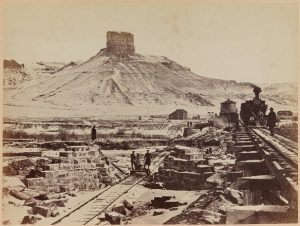
On May 10, 1869, two railroads—built with haste, hope, and aspiration—joined in the lonely desert of northern Utah at a place called Promontory. At a small ceremony that day, dignitaries from both the Central Pacific, which had built from California, and Union Pacific, which had built from Nebraska, gave speeches and installed ceremonial last spikes. The ceremonies were a moment of self-congratulation, as both enterprises had pushed tirelessly over several years to unite the country via rail. This year is the 150-year anniversary of the joining of the rails in Promontory Point and the BYU Museum of Art is commemorating this anniversary with a new exhibition entitled After Promontory.
As the region transformed, photographers were on hand to document the change. The photographic camera, like the railroad, was a new technology of the nineteenth century that found wide application across the West by the 1860s. Artists' enthusiastic documentation of transcontinental expansion offered a unique lens on the novelty and impact of the railroad in shaping the modern nation. One hundred fifty years later, this exhibition reflects on how photographers, both past and present, have responded to the transcontinental project and its continuing legacy.
This exhibition features photographs and educational material about the role of the railroad in 'the engineered West,' the lives of the many people who built the railroad, the impact of the railroad on the Native Americans living in the places where the railroad was built, Utah as an important railroad location, as well as the artistry of photographers documenting the building of the railroad, and a special section of contemporary photographs.

After Promontory is open at the BYU Museum of Art through October 5, 2019. Please visit and share with us your insights about this exhibition! We extend a special thank you to the Center for Railroad Photography & Art, with whom the MOA co-curated the exhibition, as well as the Harold B. Lee Library Special Collection, which lent photographs included in the exhibition.